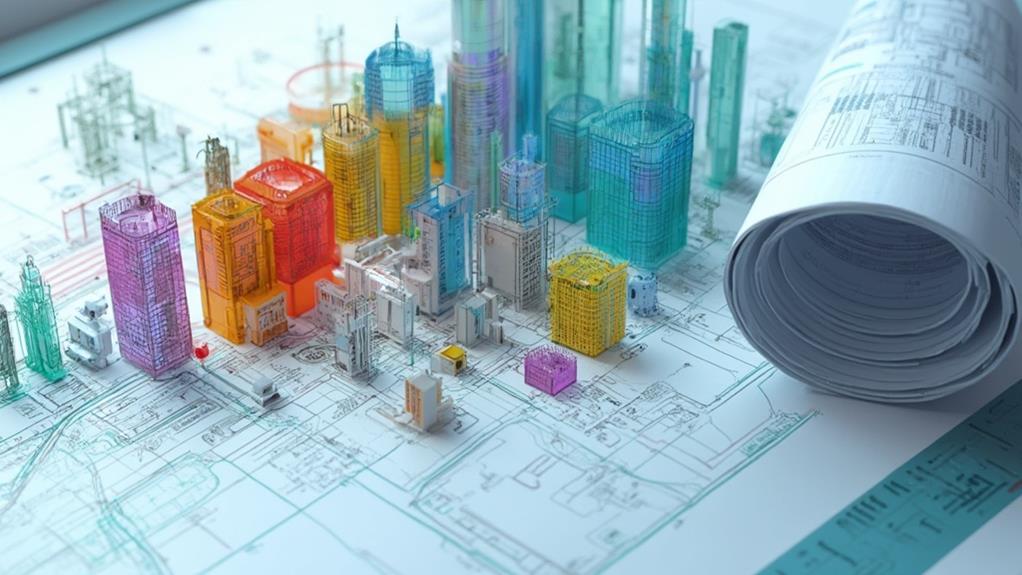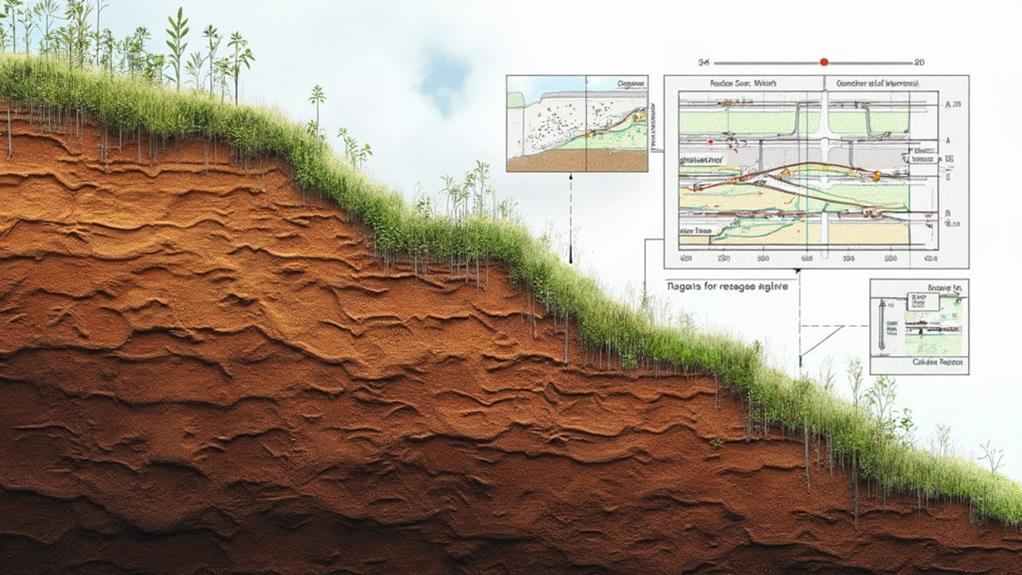When selecting retaining wall engineering software, consider its ability to perform time-efficient calculations and support efficient design processes by automating complex computational tasks. Thorough analysis tools are essential for achieving precision in design and enabling simulations for informed decision-making, which can assess impacts of soil conditions and material interactions. Opt for software with a user-friendly interface to minimize errors and enhance efficiency, facilitating the incorporation of innovative design approaches. Evaluate the software’s ability to analyze soil properties, including shear strength and drainage capabilities, and assess compatibility between soil and materials to guarantee durability. Exploring these aspects will enhance your project’s success.
Table of Contents
ToggleWalls Contractor Highlights
- Verify software capabilities align with project needs, including simulation of soil-material interactions and prediction of wall behavior under various conditions.
- Assess user-friendly interface to reduce errors, foster productivity, and accommodate users of varying expertise levels.
- Ensure software includes comprehensive analysis tools for evaluating soil properties, material interactions, and environmental impacts.
- Confirm time-efficient calculation features are available to streamline design processes and enable rapid project iterations.
- Evaluate the software’s ability to facilitate informed decision-making with precision in simulations and design assessments.
Retaining Wall Software Definition

Retaining wall engineering software is designed to streamline the complex task of designing and analyzing retaining walls by providing an integrated suite of tools that cater to the multifaceted demands of engineering projects. It encompasses key features such as load analysis, material specification, and geotechnical data integration, guaranteeing that both structural and environmental considerations are expertly managed.
Skilled crews with extensive experience in retaining wall construction can benefit from using such software to enhance their project planning and execution. These tools can help certify that walls meet building code requirements and maintain structural integrity over time.
Additionally, the user experience is optimized through intuitive interfaces and all-inclusive support resources, enabling engineers at various levels to effectively utilize the software’s capabilities.
Purpose and Functionality
Frequently employed by civil engineers and construction professionals, retaining wall engineering software serves a pivotal role in the design and analysis of retaining structures. This software provides the necessary computational power to evaluate different aspects of a retaining wall, ensuring structural integrity, safety, and efficiency. Its purpose extends beyond simple calculations, potentially transforming complex engineering tasks into manageable processes that foster inclusion and collaboration within multidisciplinary teams.
Key Purposes and Functions
- Design Optimization: With automated calculations and simulations, the software facilitates ideal design solutions, adapting to a variety of environmental conditions and material properties, which reassures engineers of their designs’ durability.
- Safety Analysis: By performing rigorous assessments, the software aids in predicting potential failure modes, such as sliding or overturning, allowing experts to implement preventative measures well in advance of construction.
- Documentation and Reporting: Seamlessly generating detailed reports, the software documents every aspect of the design process, ensuring that all stakeholders, from engineers to construction workers, have access to critical information necessary for project success.
Retaining wall engineering software, consequently, empowers professionals, creating a cohesive working environment where knowledge and skills are shared, advancing the field of civil engineering through precision and innovation.
Key Features Overview
Building upon the extensive functionality highlighted, retaining wall engineering software distinguishes itself through a suite of key features that define its utility and effectiveness in real-world applications. Notably, these features encompass broad design capabilities, guaranteeing engineers can meticulously draft retaining wall systems that align with geological and structural demands.
Sophisticated analysis tools are integrated, allowing for precise calculations of stress distribution, stability, and load-bearing capacity, which are essential for securing the safety and longevity of the engineered structures.
Additionally, the software offers robust 3D modeling and visualization functionalities. These capabilities afford users the ability to simulate and analyze complex geometries and site conditions, enhancing accuracy and efficiency in planning and construction. With access to a vast library of materials and construction methods, engineers can effortlessly tailor their designs to specific project requirements and regional regulations.
Further enriching its utility are collaboration tools that enable seamless communication among team members, fostering a coordinated design process and enhancing project outcomes. The integration of model sharing and version control ensures that all stakeholders are aligned and informed. Ultimately, the software’s array of features supports engineers in delivering precise, reliable, and innovative retaining wall solutions.
User Experience Essentials
The blueprint of intuitive user experience in retaining wall engineering software lays the foundation for efficient project execution. By prioritizing well-designed interfaces, seamless navigation, and thorough tutorials, users can cultivate an environment of productivity and collaboration. An engaging user experience guarantees that technical complexities are met with accessible solutions, empowering both novice and experienced engineers alike.
Key aspects to examine when evaluating user experiences include:
- Interface Design: A clean, organized layout simplifies task execution and reduces cognitive load, allowing engineers to focus on structural integrity and safety rather than software idiosyncrasies.
- Interactive Tutorials and Support: Accessible, detailed guides provide users with on-demand learning opportunities, facilitating skill development and confidence in using sophisticated tools.
- Customization and Flexibility: Software that adapts to various project requirements caters to diverse engineering practices, fostering a sense of belonging within communities that rely on tailored solutions.
In essence, user experience acts as the cornerstone of retaining wall engineering software. It unites users through shared objectives, guiding them in the pursuit of excellence and precision. By addressing user needs with responsive and intuitive design principles, this software enhances competency, belonging, and efficiency, ultimately contributing to successful project outcomes.
Benefits

Retaining wall engineering software vastly improves design accuracy by utilizing advanced computational methods, which leads to structurally sound and reliable outcomes. The software’s ability to perform time-efficient calculations not only streamlines the engineering process but also allows for quick iterations and updates to the design.
These tools are particularly valuable when working with complex wall materials like boulders or limestone, ensuring proper structural integrity and aesthetic appeal. Equipped with thorough analysis tools and a user-friendly interface, this software empowers engineers to efficiently manage complex projects while reducing the potential for human error.
Enhanced Design Accuracy
Incorporating advanced engineering software can markedly improve design accuracy for retaining walls. Precise modeling and simulation tools fundamentally transform how engineers approach complex geotechnical challenges, fostering more efficient and reliable solutions. By utilizing such sophisticated platforms, engineers are not only equipped to anticipate potential obstacles but also able to devise meticulously refined designs that safeguard structural integrity and longevity.
Precision in Modeling: Cutting-edge software allows meticulous simulation of environmental conditions and material behaviors, offering a robust understanding of dynamic interactions that influence design decisions.
Error Minimization: Automated calculations and simulations reduce the chances of human error, facilitating more accurate load assessments and stability analyses which are indispensable in achieving structurally sound retaining walls.
Integration Capabilities: Modern software can seamlessly integrate with other design tools, enriching the engineering workflow by enabling the synthesis of diverse data sources. This holistic approach ensures that essential factors—such as soil properties, water impact, and loadings—are extensively evaluated.
Through embracing the opportunities provided by engineering software, professionals join a community committed to advancing precision and safety in retaining wall construction, positioning themselves as leaders in the evolving field of geotechnical engineering.
Time-Efficient Calculations
Leveraging advanced engineering software streamlines calculations, considerably enhancing efficiency in the design process of retaining walls. By automating a multitude of complex computational tasks, these sophisticated tools enable engineers to focus on more critical design elements, consequently reducing the overall project timeline. They facilitate rapid iterations by handling repetitive tasks with precision and accuracy, ultimately ensuring a more cost-effective and streamlined engineering workflow.
This time efficiency does not merely save hours but potentially compresses weeks of manual calculations into a fraction of the time, fostering collaboration within engineering teams. Such software standardizes the calculation process, allowing team members to communicate more fluidly, utilizing shared models and results, therefore fostering a sense of unity and shared purpose in project outcomes.
Time-efficient calculations are particularly beneficial when faced with tight deadlines or unexpected design challenges. The ability to quickly model different scenarios and make informed decisions assures stakeholders of reliability in project delivery. Additionally, by minimizing the potential for human error associated with manual computations, this efficiency imbues the design process with a layer of confidence, reinforcing the project’s structural integrity and adherence to stringent regulatory standards.
Comprehensive Analysis Tools
Thoroughness in analysis tools offers undeniable benefits for retaining wall engineering, empowering engineers with a holistic view of project dynamics. Such extensive tools enable precision and robustness in design, allowing for more informed decision-making throughout the project lifecycle. The multifaceted capabilities of these tools guarantee that engineers can address various aspects of retaining wall design with confidence.
Detailed Simulations: Comprehensive analysis tools allow engineers to simulate real-world scenarios, evaluating the effects of various soil conditions and loadings on the retaining wall structure. This enables the prediction of potential issues before they manifest on-site, saving time and costs associated with modifications.
Material Optimization: With access to extensive databases, engineers can select the best materials for their designs, balancing cost-effectiveness with durability and performance. Such optimization directly contributes to the sustainability and efficiency of the construction process.
Systematic Stress Analysis: Advanced tools offer the ability to conduct thorough stress and stability analyses, essential for ensuring safety and reliability. These analyses help identify potential weaknesses that might compromise the integrity of the structure.
User-Friendly Interface
An intuitive user-friendly interface is indispensable for optimizing the use of retaining wall engineering software. For engineers and construction managers, a platform that offers seamless navigation and straightforward functionality greatly enhances productivity and minimizes potential errors. The advantage of having an intuitive design lies in its ability to lower the learning curve, allowing both experienced and novice users to efficiently harness the advanced tools and functionalities embedded within the software. This not only saves time but also fosters a collaborative environment, where team members feel confident in their ability to contribute without being bogged down by overly complex technicalities.
Moreover, a user-friendly interface encourages wider adoption of new technologies within an organization. When software is easy to understand and use, it promotes inclusivity, ensuring that even those less familiar with digital solutions can participate in the engineering process. This inclusivity can lead to more diverse perspectives in problem-solving, enriching the collaborative effort. The essence of a user-friendly interface extends beyond mere aesthetics; it serves as a bridge that connects human intuition with technological capabilities, consequently empowering engineers to focus on innovative design and problem-solving without getting entangled in the intricacies of software navigation.
Soil Compatibility Issues

The integration of retaining wall engineering software necessitates a thorough understanding of soil compatibility, beginning with an analysis of soil properties that includes factors like grain size distribution, moisture content, and shear strength. This understanding extends to the critical examination of material and soil interaction, which is influenced by physical characteristics and chemical processes, as well as evaluating the environmental impact on soil stability due to external factors such as weather patterns and groundwater conditions. The following table provides a succinct comparison of these critical aspects, offering insight into their dimensions and interactions:
| Aspect | Considerations | Impact on Retaining Walls |
|---|---|---|
| Soil Properties | Grain size, moisture, density | Determines load-bearing capacity |
| Material Interaction | Physical, chemical reactions | Affects durability and strength |
| Environmental Factors | Weather, groundwater levels | Influences soil stability |
| Grain Size Distribution | Fine, coarse proportions | Affects compaction efficiency |
| Moisture Content | Saturation level | Impacts soil cohesion and friction |
Analyze Soil Properties
Understanding the soil properties is a pivotal step in the engineering of retaining walls, as inadequate analysis can lead to soil compatibility issues that compromise structural integrity. Analyzing soil properties involves a meticulous examination of various geotechnical factors, each contributing to the wall’s overall stability and performance. Retaining wall engineering software aids in this essential process, allowing professionals to evaluate conditions and make informed decisions.
When analyzing soil properties using engineering software, consider the following:
- Soil Type and Composition: Knowing whether the soil is clay, silt, sand, or a mix is fundamental, as each type reacts differently under pressure and moisture. The software can provide detailed insights into the proportion and characteristics of each component, enabling better prediction of wall behavior under varying conditions.
- Shear Strength Parameters: The shear strength of the soil directly influences how much load it can sustain. The software helps in calculating these parameters, confirming that the retaining wall can withstand lateral pressures effectively.
- Drainage Properties: Proper drainage is key to prevent water accumulation behind the wall, which could lead to hydrostatic pressure. Analyzing the soil’s permeability using software tools confirms adequate measures are in place, avoiding potential failures caused by water-related issues.
Material and Soil Interaction
Evaluating soil properties equips engineers with critical insights that extend into understanding the interaction between materials and soil, a factor essential to the success of retaining wall designs. This interaction becomes particularly significant when selecting materials that need to accommodate varying soil conditions.
The compatibility between the structural elements of a retaining wall and the properties of the supporting soil can profoundly influence the wall’s durability and effectiveness. Known factors such as soil cohesion, angle of internal friction, and permeability must be meticulously assessed to align with the chosen materials, ensuring they work in unison rather than against one another.
In the domain of retaining wall engineering, software can aid in simulating these interactions, allowing designers to predict potential issues such as differential settlement, soil erosion, or wall overturning. Additionally, different types of soil, such as clay, sand, or silt, may react uniquely depending on the material chosen, necessitating a tailored approach for each project.
Environmental Impact on Soil
Amid diverse environmental conditions, engineers must navigate the challenges of soil compatibility that arise during the design and construction of retaining walls. Such compatibility issues are critical, as soil characteristics directly influence the structural integrity and long-term performance of these walls. Understanding environmental impacts on soil involves analyzing how climate, vegetation, and water flow affect soil stability and composition.
For instance, fluctuations in moisture content, resulting from seasonal rains or drought, can alter soil cohesion and bearing capacity, necessitating careful consideration during wall design.
Informed by retaining wall engineering software, engineers can anticipate these environmental impacts effectively. This technology aids in:
- Soil Classification: Identifying soil types and their geotechnical properties guides the selection of suitable wall materials and designs.
- Load Analysis: Assessing soil pressure variations due to environmental changes helps determine ideal wall dimensions and reinforcement needs.
- Erosion Control: Predicting erosion patterns enables the implementation of effective drainage solutions to maintain wall stability.
Walls Contractor FAQ
How Do I Choose the Best Software for My Specific Project Needs?
Selecting the ideal software for your project necessitates evaluating project scale, complexity, and unique requirements. Guarantee compatibility with industry standards and available support. Community reviews and expert consultations can further guide your decision towards a fitting choice.
What Are the Costs Associated With Acquiring Retaining Wall Engineering Software?
When acquiring retaining wall engineering software, costs can vary widely based on features, licensing models, and support services. Subscription fees, one-time purchases, and potential training expenses should be considered to guarantee alignment with project and budgetary requirements.
Can Retaining Wall Software Be Integrated With Other Design Tools?
Retaining wall software can often be integrated with other design tools, facilitating a seamless workflow and fostering collaboration among design teams. This integration enhances efficiency, guarantees consistency, and strengthens the sense of community within engineering and construction projects.
Are There Any Specific Hardware Requirements for Running the Software Efficiently?
To maintain retaining wall engineering software runs efficiently, it is integral to meet specific hardware requirements such as sufficient RAM, a modern multi-core processor, and enhanced graphics capabilities. This guarantees seamless integration into collaborative design environments.
How Do I Troubleshoot Common Errors Encountered During Software Usage?
To troubleshoot common software errors, first consult the user manual and FAQs. Engage with online forums or support communities where peers share solutions. If issues persist, contact technical support or explore software updates and patches.







